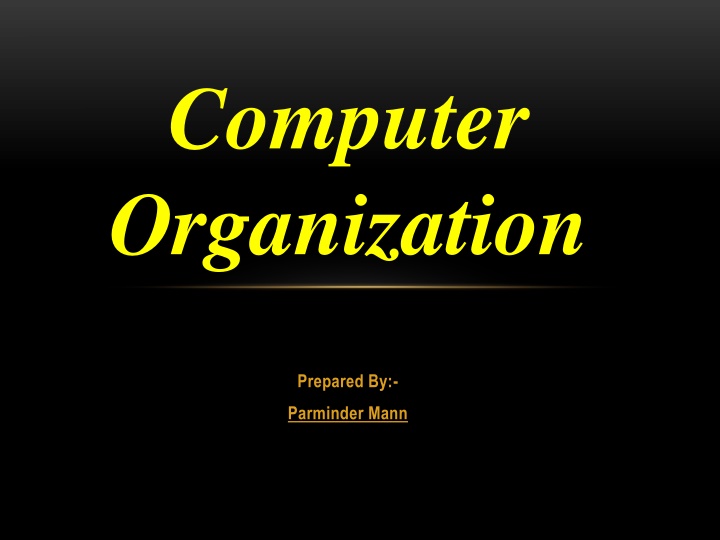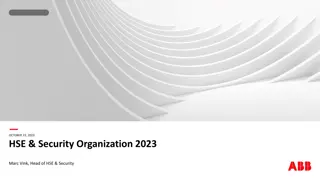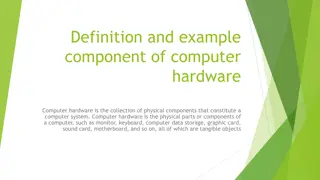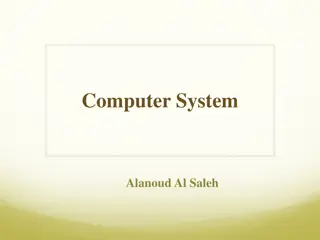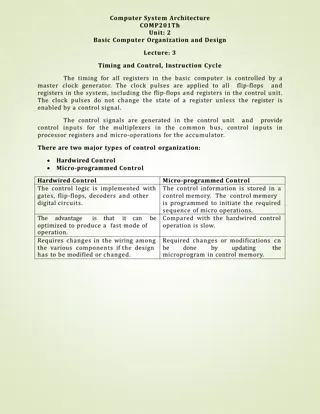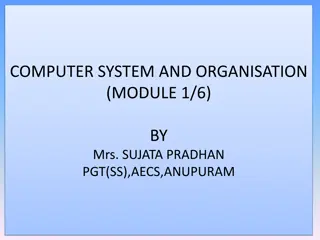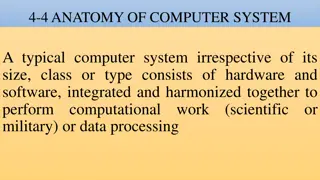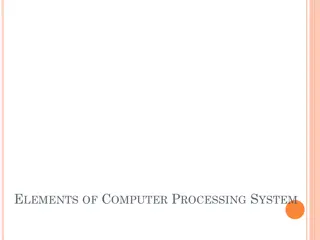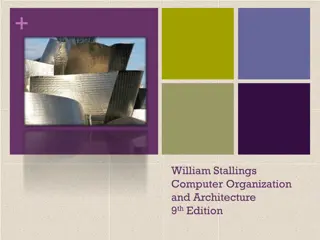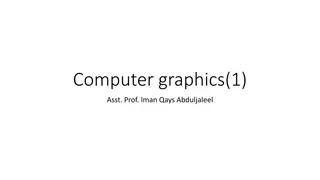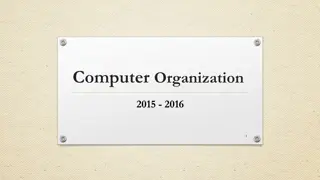Computer Organization
Distinguish between computer hardware components, learn about memory addressing, different types of memories, and how input/output devices function. Explore addressing modes and types, including implied mode, immediate mode, register mode, register indirect mode, and more.
Download Presentation

Please find below an Image/Link to download the presentation.
The content on the website is provided AS IS for your information and personal use only. It may not be sold, licensed, or shared on other websites without obtaining consent from the author.If you encounter any issues during the download, it is possible that the publisher has removed the file from their server.
You are allowed to download the files provided on this website for personal or commercial use, subject to the condition that they are used lawfully. All files are the property of their respective owners.
The content on the website is provided AS IS for your information and personal use only. It may not be sold, licensed, or shared on other websites without obtaining consent from the author.
E N D
Presentation Transcript
Computer Organization Prepared By:- Parminder Mann
OBJECTIVES After reading this chapter, the reader should be able to: Distinguish between the three components of a computer hardware. List the functionality of each component. Understand memory addressing and calculate the number of bytes for a specified purpose. Distinguish between different types of memories. Understand how each input/output device works.
ADDRESSING MODES Addressing Modes: * Specifies a rule for interpreting or modifying the address field of the instruction (before the operand is actually referenced) * Variety of addressing modes - to give programming flexibility to the user - to use the bits in the address field of the instruction efficiently
TYPES OF ADDRESSING MODES Implied Mode Address of the operands are specified implicitly in the definition of the instruction - No need to specify address in the instruction - EA = AC, or EA = Stack[SP], EA: Effective Address. Immediate Mode Instead of specifying the address of the operand, operand itself is specified - No need to specify address in the instruction - However, operand itself needs to be specified - Sometimes, require more bits than the address - Fast to acquire an operand Register Mode - Designated operand need to be in a register - Shorter address than the memory address - Saving address field in the instruction - Faster to acquire an operand than the memory addressing - EA = IR(R) (IR(R): Register field of IR) Address specified in the instruction is the register address
TYPES OF ADDRESSING MODES Register Indirect Mode Instruction specifies a register which contains the memory address of the operand - Saving instruction bits since register address is shorter than the memory address - Slower to acquire an operand than both the register addressing or memory addressing - EA = [IR(R)] ([x]: Content of x) Auto-increment or Auto-decrement features: Same as the Register Indirect, but: - When the address in the register is used to access memory, the value in the register is incremented or decremented by 1 (after or the execution of the instruction) before
TYPES OF ADDRESSING MODES Direct Address Mode Instruction specifies the memory address which can be used directly to the physical memory - Faster than the other memory addressing modes - Too many bits are needed to specify the address for a large physical memory space - EA = IR(address), (IR(address): address field of IR) Indirect Addressing Mode The address field of an instruction specifies the address of a memory that contains the address of the operand - When the abbreviated address is used, large physical memory can addressed with a relatively small number of bits - Slow to acquire an operand because of an additional memory - EA = M[IR(address)] location be access
PROGRAM INTERRUPT Types of Interrupts: External interrupts External Interrupts initiated from the outside of CPU and Memory - I/O Device -> Data transfer request or Data transfer complete - Timing Device -> Timeout - Power Failure Internal interrupts (traps) Internal Interrupts are caused by the currently running program - Register, Stack Overflow - Divide by zero - OP-code Violation - Protection Violation Software Interrupts Both External and Internal Interrupts are initiated by the computer Hardware. Software Interrupts are initiated by texecuting an instruction. - Supervisor Call -> Switching from a user mode to the supervisor mode -> Allows to execute a certain class of operations which are not allowed in the user mode
RISC: REDUCED INSTRUCTION Historical Background IBM System/360, 1964 - The real beginning of modern computer architecture - Distinction between Architecture and Implementation - Architecture: The abstract structure of a computer seen by an assembly-language programmer SET COMPUTERS -program Compiler High-Level Language Instruction Set Hardware Architecture Implementation Continuing growth in semiconductor memory and microprogramming -> A much richer and complicated instruction sets => CISC(Complex Instruction Set Computer) - Arguments advanced at that time Richer instruction sets would simplify compilers Richer instruction sets would alleviate the software crisis - move as much functions to the hardware as possible - close Semantic Gap between machine language and the high-level language Richer instruction sets would improve the architecture quality
CHARACTERISTICS OF RISC Common RISC Characteristics - Operations are register-to-register, with only LOAD and STORE accessing memory - The operations and addressing modes are reduced Instruction formats are simple More characteristics are as: - Relatively few instructions - Relatively few addressing modes - Memory access limited to load and store instructions - All operations done within the registers of the CPU - Fixed-length, easily decoded instruction format - Single-cycle instruction format - Hardwired rather than microprogrammed control
COMPLEX INSTRUCTION SET COMPUTERS: CISC High Performance General Purpose Instructions Characteristics of CISC: 1. 2. 3. 4. 5. A large number of instructions (from 100-250 usually) Some instructions that performs a certain tasks are not used frequently. Many addressing modes are used (5 to 20) Variable length instruction format. Instructions that manipulate operands in memory.
MAJOR COMPONENTS OF CPU Storage Components: Registers Flip-flops Execution (Processing) Components: Arithmetic Logic Unit (ALU): Arithmetic calculations, Logical computations, Shifts/Rotates Transfer Components: Bus Control Components: Control Unit Register File ALU Control Unit
MEMORY STACK ORGANIZATION 1000 Memory with Program, Data, and Stack Segments Program (instructions) PC Data AR (operands) 3000 SP stack 3997 3998 3999 4000 - A portion of memory is used as a stack with a processor register as a stack pointer 4001 DR SP - 1 DR DR M[SP] SP + 1 SP - PUSH: M[SP] - POP: SP - Most computers do not provide hardware to check stack overflow (full stack) or underflow(empty stack)
INSTRUCTION FORMAT Instruction Fields OP-code field - specifies the operation to be performed Address field - designates memory address(s) or a processor register(s) Mode field - specifies the way the operand or the effective address is determined The number of address fields in the instruction format depends on the internal organization of CPU - The three most common CPU organizations: Single accumulator organization: ADD X General register organization: ADD R1, R2, R3 ADD R1, R2 MOV R1, R2 ADD R1, X Stack organization: PUSH X ADD /* AC AC + M[X] */ /* R1 R1 + R2 */ R2 */ R1 + M[X] */ R2 + R3 */ /* R1 /* R1 /* R1 /* TOS M[X] */
THREE, AND TWO-ADDRESS INSTRUCTIONS Three-Address Instructions: Program to evaluate X = (A + B) * (C + D) : ADD R1, A, B /* R1 ADD R2, C, D /* R2 MUL X, R1, R2 M[A] + M[B] M[C] + M[D] /* M[X] */ */ R1 * R2 */ - Results in short programs - Instruction becomes long (many bits) Two-Address Instructions: Program to evaluate X = (A + B) * (C + D) : MOV R1, A /* R1 ADD R1, B /* R1 MOV R2, C /* R2 ADD R2, D /* R2 MUL R1, R2 /* R1 MOV X, R1 /* M[X] M[A] */ R1 + M[B] */ M[C] */ R2 + M[D] */ R1 * R2 */ R1 */
ONE, AND ZERO-ADDRESS INSTRUCTIONS One-Address Instructions: - Use an implied AC register for all data manipulation - Program to evaluate X = (A + B) * (C + D) : LOAD A /* AC M[A] */ ADD B /* AC AC + M[B] STORE T /* M[T] AC */ LOAD C /* AC M[C] */ ADD D /* AC AC + M[D] MUL T /* AC AC * M[T] STORE X /* M[X] AC */ Zero-Address Instructions: - Can be found in a stack-organized computer - Program to evaluate X = (A + B) * (C + D) : PUSH A /* TOS PUSH B /* TOS ADD /* TOS PUSH C /* TOS PUSH D /* TOS ADD /* TOS MUL /* TOS POP X /* M[X] */ */ */ A B (A + B) C D (C + D) (C + D) * (A + B) */ TOS */ */ */ */ */ */ */
MULTIPROCESSOR A multiprocessor is a computer system with two or more central processing units (CPUs), with each one sharing the common main memory as well as the peripherals. This helps in simultaneous processing of programs. The key objective of using a multiprocessor is to boost the system s execution speed, with other objectives being fault tolerance and application matching. Benefits of using a multiprocessor include: Enhanced performance Multiple applications Multiple users Multi-tasking inside an application High throughput and/or responsiveness Hardware sharing among CPUs
DIFFERENT WAYS OF USING A MULTIPROCESSOR As a uniprocessor, such as single instruction, single data (SISD) Inside a single system for executing multiple, individual series of instructions in multiple perspectives, such as multiple instruction, multiple data (MIMD) A single series of instructions in various perspectives, such as single instruction, multiple data (SIMD), which is usually used for vector processing Multiple series of instructions in a single perspective, such as multiple instruction, single data (MISD), which is used for redundancy in failsafe systems and, occasionally, for describing hyper-threading or pipelined processors
PIPELINING Pipelining is the process of accumulating instruction from the processor through a pipeline. It allows storing and executing instructions in an orderly process. It is also known as pipeline processing. Pipelining is a technique where multiple instructions are overlapped during execution. Pipeline is divided into stages and these stages are connected with one another to form a pipe like structure. Instructions enter from one end and exit from another end. Pipelining increases the overall instruction throughput. In pipeline system, each segment consists of an input register followed by a combinational circuit. The register is used to hold data and combinational circuit performs operations on it. The output of combinational circuit is applied to the input register of the next segment.
Pipeline system is like the modern day assembly line setup in factories. For example in a car manufacturing industry, huge assembly lines are setup and at each point, there are robotic arms to perform a certain task, and then the car moves on ahead to the next arm.
MIMD COMPUTERS MIMD computers are consisting of 'n' processing units; each with its own stream of instruction and each processing unit operate on unit operates on a different piece of data. MIMD is the most powerful computer system that covers the range of multiprocessor systems. The block diagram of MIMD computer is shown.
SIMD COMPUTERS SIMD computers are consisting of n' processing units receiving a single stream of instruction from a central control unit and each processing unit operates on a different piece of data. Most SIMD computers operate synchronously using a single global dock. The block diagram of SIMD computer is shown below:
